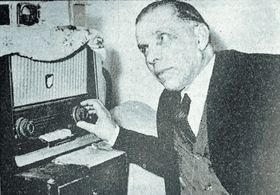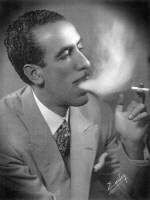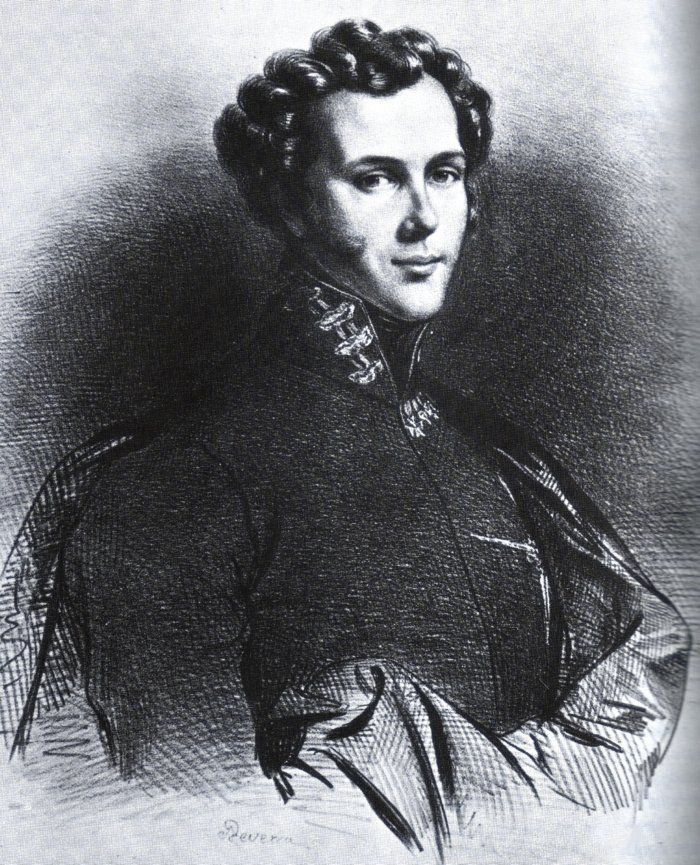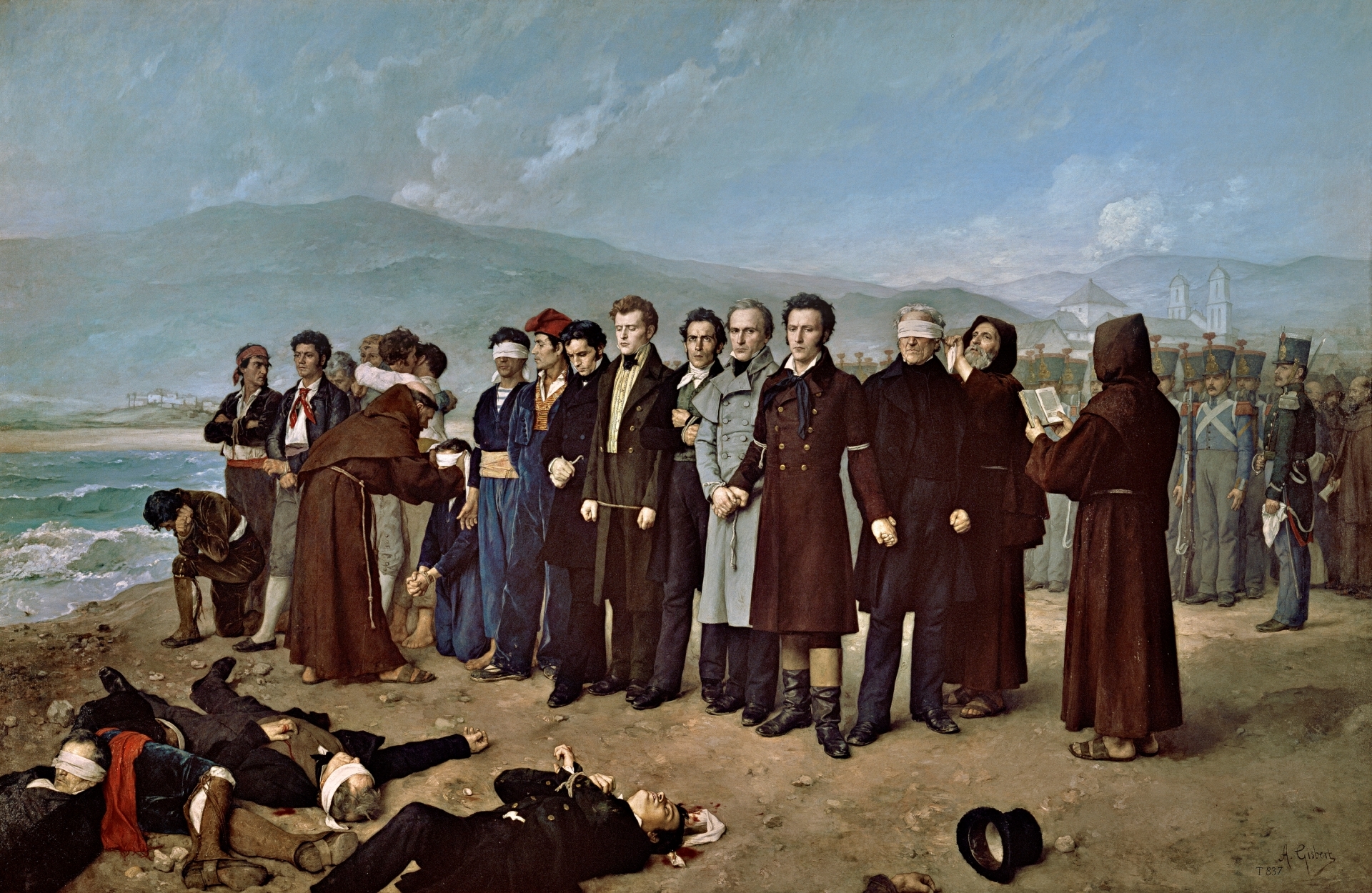Mijas - local celebrities
GENERAL TORRIJOS
General Torrijos, although from Madrid, is tied to Andalusia for his many activities here. From Andalusia he revived the fight for freedom against the despotic king Fernando VII. It was in Andalusia where he died, in Málaga, executed by those he fought against.
Jose María de Torrijos y Uriarte was born in Madrid the 20th March, 1791. He came from a noble family and joined the army very young, first as a pageboy for King Carlos IV at ten years old and when he was thirteen he achieved the title of captain of the Ultonian regiment, though he couldn’t exert it due to his young age. In 1808, he enrolled in the Academy of Alcalá de Henáres, where he was surprised by the Independence war, fighting bravely from the beginning against the French. He was promoted to colonel in 1813 and married Luisa Sáenz de Viniegra in Badajoz. He obtained all types of military decorations and a proposition from the Duke of Wellington for Brigadier, which materialised at the end of the war, a war where he fought under the orders of his future executioner, Captain Vicente González Moreno.
The re-establishment of absolutism annulled the constitution of 1812 and because of this he joined the Liberal Party and refused to leave for América to fight against the Independentists. Andalusia was vital for any attempted rebellion, the troops being concentrated here ready to leave for América where the colonies were fighting against the Spanish. In 1817, Torrijos participated in the attempted rebellion of General Lacy to raise the army in Andalusia and because of this was taken to prison, first to the Castle of Santa Bárbara in Alicante and later to the Santo Oficio prison in Murcia.
With the victorious rebellion of Riego in 1820 he was set free and the Liberal Triennium named him commissioner of war at the beginning of 1823, directing the resistance against the “One hundred thousand children of San Luis” the French army being sent by the European powers to replace the absolutists in the Spanish government.
After being defeated in Cartagena, Torrijos and his wife were forced to flee to Marseilles and from there to England (1824), where he contacted with the rest of the liberals in exile.
In England he formed a friendship with John Sterling, a well known landowner who presented him to Robert Boyd, ex_official of the English army in India who had fought in the Greek Independence war. Boyd, a romantic like Torrijos, committed himself to help him recover the freedom in Spain through his good name and fortune.
With the support of the “Apostles of Cambridge”, a radical society of exiled liberal Spaniards in England, and commissioned by the “Board of directors of the Spanish Uprising”, they arrived in Gibraltar in September 1830, disembarking on the 9th, meeting with old collaborators such as the ex_president of the Spanish parliament, Manuel Flores Calderón, the ex_minister of war, Francisco Fernández Golfín and other important military figures. After deciding that a rebellion of the army against the absolutist government would be hard to achieve, they attempted a raid on Algeciras on the 24th October and another on the 11th November. As both of them failed, Torrijos was forced to hide in boats anchored in Gibraltar.
At the end of January 1831 they took action against La Linea of which they took hold, but this initial success failed again faced with Algeciras. At the end of February another attempted rebellion cost the life of Colonel Manzanares.
Seeing it impossible to act in the Gibraltar region because of the extreme vigilance, Torrijos received with high spirits the secret letters of a “very confidential” friend, with the nickname of Viriato he informed him that the best place to disembark was Vélez Málaga, and that with the presence of the Málaga troops first, and later those of all Andalusia, they would rebel against the King Fernando VII.. In fact this was a trap planned by his old comrade-in-arms and now Governor of Málaga Vicente González Moreno, who under the name of “Viriato” took advantage of Torrijos´s impatience and planned his capture.
On the 30th November 1831 they left Gibraltar in various hulls only to find they had been deceived when they reached the point of Calaburras and found the Neptune ship waiting for them. Because of this they were forced to disembark in Mijas Costa (Charcón beach) and flee inland. First they arrived in Mijas where they received several gunshots from the armed military forces and then crossed the mountains to Alhaurín de la Torre where they had the same welcome. After being persecuted by the infantry they found refuge in a farmhouse belonging to the Count of Mollina, with an ancient Arab tower near the old road to Cártama. Once there, surrounded by the troops sent by González Moreno and after taking both generals, he was forced to surrender along with his 52 men on the 5th December, being captured and sent to Málaga.
In Málaga, in different jails, they lived the same length of time that it took González Moreno to send a messenger to Madrid, General Narváez. He returned on the 10th December with an execution order given by the decadent and bloodthirsty Fernando VII, who wrote with his own hand: “Execute them all. I, the King”.
At 11:30 am on the 11th December 1831 on the Málaga beaches of San Andrés, in front of the Carmen district, they were all executed without exception, including the Englishman Robert Boyd and a young cabin boy from the boat. Flores Calderón and Fernández Golfín also perished along with other soldiers and sailors. Torrijos was denied his last request which was to give the order to open fire and die without their eyes covered.
Their bodies were buried in the San Miguel cemetery, except for Robert Boyd who went to the recently inaugurated English cemetery, until 1842, when the city council of Málaga built on popular demand a funeral monument (an obelisk) which was erected in their honour in Plaza Riego, today Plaza de la Merced, in front of the native house of the painter Pablo Ruiz Picasso, under which they all rest. A cross also commemorates the place of his death, now a promenade.
The Governor González Moreno, who from then on was known as “The executioner of Málaga” received for his treason a promotion to General Lieutenant and the post of Captain-General of Granada. When the Carlista war broke out he died assassinated by army volunteers in 1839.
The sacrifice of Torrijos and his comrades was not in vain and they were remembered constantly in the following years for after the death of King Fernando VII in 1833, the liberals obtained the power and the widow of Torrijos, Dª Luisa Carlota Sáenz de Viniegra was honoured with the title of Countess of Torrijos. His death, and the death of Mariana Pineda, was one of the last caused by the absolutism in Andalusia.
More information about Torrijos´ route
The Execution of Torrijos and his Companions on the San Andrés Beach at Malaga (Museo del Prado - Madrid)
THE HERMIT, DIEGO DE JESÚS, MARÍA Y SAN PABLO
The return of the “Virgen de la Peña” (Virgin of the Rock) in 1586 brought great joy to Mijas, but even though the testimony of the two kids who had witnessed the apparition of the Virgin was already known at the City Hall, the men there took no rush in complying with the Virgin’s request of having her chapel made in the rock below the La Peña Castle. In fact, the project stayed paralyzed for 70 years, and it might well have stayed that way if it hadn’t been for the faith, perseverance and love for the Virgin of a pious hermit, Brother Diego de Jesús, María y San Pablo.
One day in 1656, after having tried for years to get the attention of civilian and ecclesiastic authorities, the small hermit took his pick and attacked the rock. At first he became the laughingstock of the plebs, but soon they took pity on him and people from the town brought him water, bread and cheese, but nobody helped him in his task.
Brother Diego never fainted, day after day during the next 26 years he restlessly carved the hard rock, and his huge act of faith won the respect and awe of the entire town. When the Sanctuary of the Virgin was finally completed in 1862 he was invited to Council meeting to be honoured. Brother Diego took the occasion to propose the “Castillo de la Peña” (Castle of the Rock), which had been abandoned for more than 100 years and was almost in ruins, to be repaired by the Villa and transformed in a Convent-Hospice for the order of the Carmelitas Descalzos.
The small Brother, by then already considered as a living saint, made this request in such a moving way that the authorities unanimously voted in favour, but given the magnitude of the project and its cost they decided that the decision needed to be ratified in an open Council reunion with the presence of the whole Mijas population. Consequently, the next afternoon, on September 8th 1682, the day of the Virgin festivities, the bells rang to summon the people at the plaza. Old documents describe that historic day: The two regiments of the Mijas Militia, shining in their gala uniforms, with flags and banners waving in the wind, stood in formation on one side of the Plaza de los Álamos; judges and civil authorities dressed in their most splendorous clothing stood in front of them on the opposite side; on the other two sides, and also with their best attires, stood the whole population of Mijas.
On the centre of the plaza stood the Council members and Brother Diego in his brown robes, the Carmelita habit. The secretary of the Villa read Brother Diego’s proposal aloud; the annals of that period show that, after citizens of every condition showed their approval, the project was definitively approved unanimously, it was also agreed that the Order of the Carmelitas Descalzos would take the humble Brother in their bosom for good; and at the time of his death he would be buried there, receiving all the rites reserved for the monks of the Convent-Hospice that was about to be built on top of the rock he had carved. He in turn requested for his tomb to have nor markings whatsoever, it was enough for him for his bones to rest beside the place where he had placed all his work and love, the “Virgen de la Peña”.
The eremite Diego de Jesús, María y San Pablo, died saintly on July 6th 1731 according to the death certificate found in the Parish on the book 5, page III. There was a bell named “Virgen de la Peña y el hermano Diego de Jesús”, its weight was 170 kilos. His remains rest in the Virgen de la Peña Hermit in Mijas, in compliance of the aforementioned agreement that took place on September 8th 1682.
Brother Diego’s Hospice thrived until 1831, when Mendizábal ordered the secularization of religious orders and took possession of all their assets; the Hospice was closed and the Carmelitas Descalzos left Mijas. Abandoned, the Hospice crumbled down and was looted by vandals throughout the years. Many used the looted materials to build their own homes. Everything was taken or destroyed except a rebuilt tower and a wall section above the Virgin’s Chapel, where it is believed that the holy remains of Brother Diego rest in his anonymous tomb, although other documents suggest that he was moved to the Parish.
Today, only a few scattered rocks mark the spot where the dream of the small Brother once stood, but the Sanctuary of the Virgen de la Peña, which he carved with his own hands, still stands as a monument to his faith and is visited both by locals and foreigners, is the heart of the great festivities and more so the heart of the whole town itself. And it’s not only on joyful days like weddings and parties when the people of Mijas come to it, but even with greater devotion in times of difficulty, sadness or illness, and it’s many a deed of mercy and consolation that’s been attributed to the Virgin.
MANUEL CORTÉS QUERO "The Mole of Mijas"

In the following paragraphs we have tried to give a general vision of the 30 years Manuel Cortés Quero was hidden because of his belief in democracy and socialism. They have been taken out of the book “Los Topos” – The Moles – by Jesús Torbado and Manuel Lequineche and edited by Argos-Vergara in 1977.
...The Mayor of Mijas has joined exodus with his wife and his one and a half-year-old daughter, María. “The fall of Málaga, does not mean the end of the Republic,” thinks Cortés. After marching, with great difficulty, through the woods all day looking for the Almería road, Cortés decides that his wife and daughter should return to Mijas. “Juliana, you have never been involved with politics, they won’t hurt you.” The Mayor embraces his wife, gives her fifty pesetas and kisses his daughter before leaving for Almería...
...Two years later, Manuel Cortés has lost the war. His division “La cuarenta de Carabineros” has been demobilised in Valencia. He says good bye to his friends of war and in the middle of all the chaos at the time, in Valencia, he decides to go back to his village, in the Málaga mountains, to be with his wife and daughter. His conscience is clear; he is only a defeated soldier, one of the six hundred thousand soldiers that have lost the war....
...I use to go out at night, like the owls, to relax and stretch my stiff legs and move my arms. My muscles were numb and my joints sore. I would lay down on my old rough bed, walk up and down the room, being careful not to make any noise, trying not to cough. In reality, the fact of being in such a busy as a bar and barbershop benefited me. Who would ever look for me in such a busy place?...
...I use to drink water and very rarely wine. I had never been a wine drinker. My habit was tobacco, I would smoke all the rationing I was brought. I had constant discussions with Juliana about the subject. “They are going to see the smoke, Manolo, one day they will see the smoke...” It was impossible that they would have seen the smoke, but Juliana was obsessed with any fault with the security system...
...The first two years were the most depressing for me, until we decided to move to a house... It had a spare room, a hidden room, where I could break the silence and live with Juliana and my daughter María. And that’s just what we did. Juliana rented the house, number 5 in Capitán Cortés Street, from a friend. The house had a cupboard that once had been used to hide the image of the Sacred Heart of Jesus...
...As soon as we arrived, we put hands to work. We had to clear the cupboard and clean it out. That was my hiding place for a few days until I could prepare a new hideout. This was situated under the stairs. I drilled a hole that made way to the space under the stairs and made a large tile of plaster to disguise the hole and painted it a red colour. When the owner of the house would visit to pick up or leave the olive oil containers, I would run and hide under the stairs and the owner never suspected that had been some building done there, a false wall that led to the hidden space under the stairs. To do all this work, we picked Thursday and Friday of Easter Week as we knew that our neighbour attended Mass punctually and this way would not hear the work going on through the thin walls. The noise of the saw blended in with the drums and music of the processions...
...I have to admit that some days I was desperate; I needed to escape, go out, no matter what. I felt discourage and Juliana and María would pay for my bad moods...
...I pulled out my own teeth, as soon as I got an ache, patiently, I would work at the tooth until it was loose and then I would yank it out with my fingers without any pliers or tongs. I pulled out nine or ten teeth this way. Juliana would warn me, “be careful if it gets infected you will be in a bad way”. I would place myself in front of the mirror and try and loosen the tooth in question, curled up in pain I would yank the tooth out. The worst were the ones that would not loosen. When I got out, I went to the dentist, one in Mijas and another in Ronda, I had to have four back-teeth out...
...In 1960, my daughter got married. I had to make do watching her come out of church through a little hole above. The wedding procession left the house and after the ceremony María scurried away to come to my room and kiss me, just as we had planned. Down-stairs the groom was looking for her “Where ever has this woman got to?” On their honeymoon, María confessed everything. Silvestre, her husband, was not bothered at all, “Now, I understand all the small noises from upstairs, why you use to take so long every time you left the house and why you always threw me out of the house just before a good television programme...”
...There wasn’t much more to wait, less than I expected, to return to life and exist legally. On Friday the 28th of March, 1969 at 10 o’clock in the evening, like always I had my ear stuck to the radio waiting to hear the report of the governmental agreements. Manuel Fraga Iribarne, Minister of Information and Tourism, was the man in charge of giving out these reports. I got a lump in my throat when I heard the Minister speak, because of the emotion of the moment, I couldn’t think straight; something had been said about Franco giving amnesty to the persons who had committed crimes from the 18th of July of 1936 to the 1st of April 1939.
This is what I had been waiting to hear for the last 30 years. I stopped and thought to myself, “Manolo, this could be a dream, calm down, don’t go and spoil everything now”.
I rushed down the stairs; Juliana was in the living room sewing. “Juliana, I have just heard over the radio something about an amnesty that Franco has given, you must ask the porter of the Town Hall the Official State Bulletin...”
EL PROFESOR MAX

He was born in Brihuega (Guadalajara). He studied medicine, was a school teacher and a “practicante” (nurse specialising in giving injections). He entered the old school of journalism “El Debate” and was also a hypnotiser and self-taught magician very well-known throughout the world. He was a bohemian, traveller and adventurer and his taste for antiques led him to collect small objects, according to him, because he had neither the money nor a big house to keep the largest ones.
He travelled all over Europe and Africa with the show “A man and a suitcase are the greatest show on earth”.
He spent the longest period in Africa, perhaps drawn by his adventurous spirit. From these experiences he recounted endless anecdotes amongst which the most memorable were always the strategies he had to employ to get the miniatures. On one occasion, he was unable to gain access to a “Bauluba” tribe and he had to organise a session of hypnotism on the path which the chief of the tribe had to take. When the chief, who was a witch-doctor, saw how he used his powers of hypnosis on some members of the tribe, he offered him whatever he wanted if he would reveal his secrets. From this meeting Professor Max obtained the shrunken head of a white man, the most valuable item in the museum. Professor Max told haw the hair had been analysed by the F.B.I., who certified that the head was of a white man, who appeared to have been a Caucasian missionary who had travelled those distant lands a hundred years ago. Some authors are of the opinion that since it is the shrunken head of a white man it is unique in the world.
On his travels, he collected miniatures from all over the world with the intention to open a museum in his old age which would provide him an income. Eventually, he collected 30,000 miniatures, valued at one hundred million pesetas. (600,000€)

